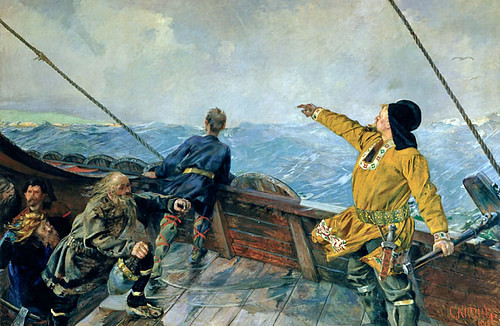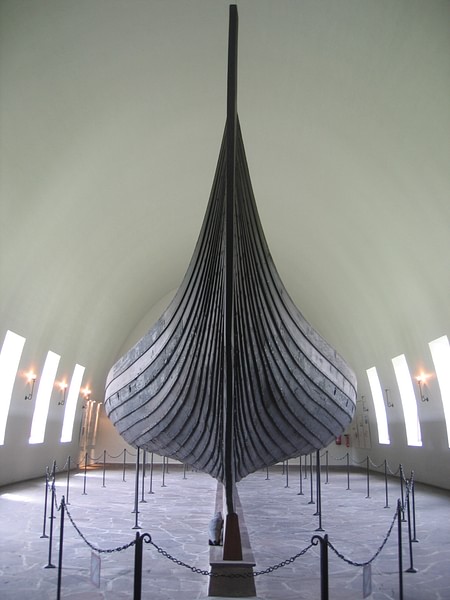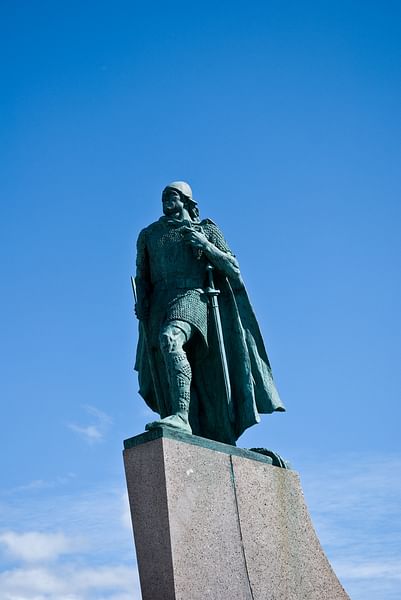The idea that it was the Norse who discovered America first emerged in the late 18th century, long before there was any public awareness of the sagas on which such claims were based. In the course of the 19th century, evidence for a Norse presence was discovered in what is now the United States. This evidence, in the form of inscriptions and Norse artefacts, generally appeared in areas of Scandinavian settlement, and advocates of the authenticity of this evidence tended to be of Scandinavian descent.

Leif Erikson Sighting America
Nasjonalgalleriet Oslo (Public Domain)
Public awareness of the idea of a Norse discovery of America prior to Christopher Columbus (l. 1451-1506) broadened with the publication by Rasmus Anderson of America not discovered by Columbus in 1874. This book lent powerful support both to the historic contention that the Norse visited New England repeatedly from the 10th to the 14th centuries and to the Teutonic ancestral link between the Norse and the New England cultural elite known (in the memorable phrase of Oliver Wendell Holmes) as "the Brahmin caste of New England".
The Viking
On 30 April 1892, the replica of the Gokstad ship sailed from Bergen, & 22 days later, it reached the shores of America.
The high-water mark of the Norse discovery hypothesis came in 1893, three years after the 9th-century Gokstad ship (now in the Viking Ship Museum in Oslo) had been found in a burial mound on Kristianiafjord (now Oslofjord). The quatercentenary of Columbus' first voyage was marked across America in 1892, and the following year the World's Columbian Exposition was mounted in Chicago to celebrate Columbus' arrival. It was agreed that the Norwegian contribution would be a reconstruction of the Gokstad ship, which would be sailed across the Atlantic (to prove that such a ship was capable of the voyage) to make landfall in New London (Connecticut) and New York before making its way to Chicago, where it would be an exhibit at the Exposition.
The ship was certainly capable of such a voyage: although it lacked thwarts, it was very strong, and it could be powered by oar or sail. Funding was raised in Norway and from Scandinavians in America. On 30 April the Viking (as the replica was called) sailed from Bergen under the command of the newspaper publisher Magnus Andersen, and 22 days later it reached the shores of America. The American welcome was tumultuous, but not entirely without incident. Anderson's account was published in Norwegian (Vikingefærden, i.e. "Viking expedition") but not in English, and so was never tested against the recollections of Americans who were present; there is no reason to think it unreliable, but it does represent a particular perspective.
In this account, Andersen and his crew were attacked in Brooklyn by defenders of Columbus, and the police (Irish Catholics, and so pro-Columbus) treated them as perpetrators rather than victims and held them in the police cells. And as the Viking proceeded inland along the Erie Canal to the Great Lakes, the crew was greeted with cries of execration from Columbus enthusiasts on bridges and canal banks. In Anderson's view, this was a confessional divide: Catholics championed Columbus, and Protestants championed the Vikings. This view had already been embedded in popular Protestant culture by writers such as Marie Brown, who in her The Icelandic Discoverers of America; or Honour to Whom Honour is Due (1887) had presented the promotion of Columbus' "fraudulent discovery" as an attempt to make the United States subject to "the foulest tyrant the world has ever had, the Roman Catholic power".
The Viking was an anomalous presence at an event designed to celebrate Columbus, and it proved to be a cuckoo in the Columbian nest. Anderson and his many supporters stoutly supported the contention that Leif Erikson had preceded Columbus in America. Indeed, the fact that the Viking had sailed the Atlantic without support vessels whereas the replicas of Columbus' three ships were unseaworthy and so had to be towed across the Atlantic from the Monasterio de La Rábida (the monastery where Columbus stayed while waiting for funding for his voyage) was absorbed into a larger narrative of Scandinavian priority and supremacy. Both narratives are of course mythical – Columbus did not visit what is now the United States, nor is there any evidence that Leif Erikson did so – but both served ideological purposes. Columbus was important for Catholics, especially Italians and Hispanics. The Vikings were important for both the east coast elites and the Scandinavian settlers in the Midwest.

Gokstad Viking Ship
Karamell (CC BY-SA)
The voyage of the Viking supported both fantasy archaeology (it stopped at Newport Connecticut, home of the 'Viking' Newport Tower) and an ethnic narrative. Commentators were not slow to contrast the manly Norwegians who braved the Atlantic in an open boat with the effeminate Spanish sailors who declined to sail their large vessels across the ocean. The progenitors of New Englanders were deemed to be courageous proto-Protestant Norsemen. This was an appropriation of a similar myth in Britain, memorably articulated by Thomas Carlyle in the first of his lectures in On Heroes, Hero-worship and the Heroic in History, in which he characterised the "Sea-Kings" of the "Northmen" as having "wild bloody valour" and "indomitable rugged energy", and lauded their courage, picturing them "defying the wild ocean with its monsters, and all men and things – progenitors of our own Blakes and Nelsons". The voyage of the Viking encouraged Anglo-Saxon New Englanders and Scandinavian Midwesterners to share in this heroic Nordic ancestry.
The Myth of Discovery
Why does the question of who discovered America arise? Why is the discovery celebrated? And why do so many people argue about who arrived first? And why does the Norse presence in North America matter? Indeed, why do many Americans continue to believe that the Norse preceded Columbus in the United States (which Columbus never visited)? Why have Americans paid for statues of Leif Erikson to be erected in Iceland and Greenland?
The seeds of the answers to such questions lie in the early European colonisation of America, and in the emergence, after early Spanish domination, of the English as the most successful colonial power. Looking back from the perspective of the 21st century, we may legitimately wonder what could have made the colonists feel entitled to conquer and occupy someone else's homeland, to disinherit and force to the margins of society the people that they displaced and go on to enslave the peoples of another continent? What is the origin of this sense of superiority, and how did it lead to a spurious historiography whereby America was founded by Vikings?
The larger context for such questions is the process whereby a colonising society, through its politically empowered elite, creates a history in which the colonised are characterised as savages and marginalised with respect to land. Racial hierarchies of colonisation disenfranchise Native Americans from their past and advance North Europeans as racially and culturally superior, and so rightful claimants of Native American lands.

Leif Erikson
Thomas Quine (CC BY)
The Norse crossed the North Atlantic, settling in the Atlantic archipelago, the Faroes, Iceland, and Greenland, and reaching further west to the edges of the North American mainland. There was nothing inevitable about this journey westward; no magnet was drawing the Norse to their destiny in America. The belief that the Norse were the first Europeans to come to what is now the United States has been difficult to sustain in the absence of archaeological evidence.
The need to sustain the belief had a number of consequences. Leif Erikson, a legendary figure, was hardened into a solid historical figure, the discoverer of America, and statues of Leif have been erected by Americans in Iceland (Reykjavík and Eiríksstaðir), Greenland (Qassiarsuk), and the United States (Boston, Chicago, Duluth, Milwaukee, St Paul and Seattle). A massive statue of Thorfinn Karlsefni stands in Philadelphia, but as I write (2019), it has been toppled into the river, possibly by aggrieved defenders of Columbus.
Another effect of the belief that the Norse 'discovered' America is that ambiguous artefacts are tendentiously interpreted, so the Maine Penny, the Newport Tower, and the mounds of Ohio and the lower Mississippi, all of which are genuine artefacts, become 'proof' of a Norse presence in America. In the case of the mounds, the notion that they are the work of Vikings serves to dispossess native Americans by denying their relationship to the artefacts that their ancestors constructed.